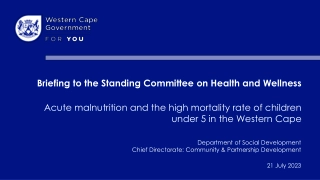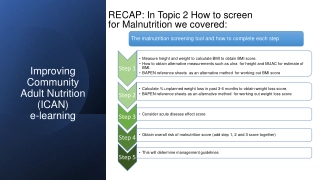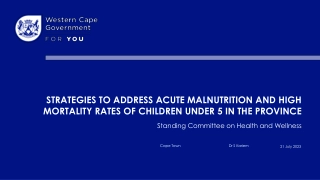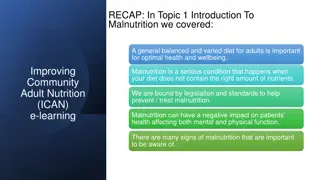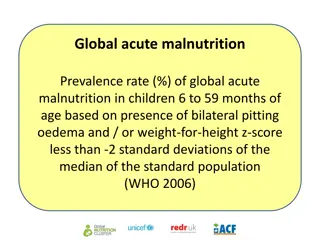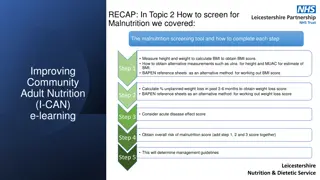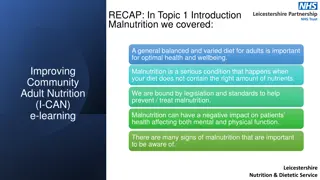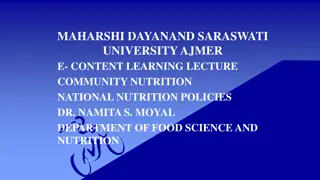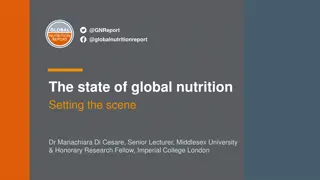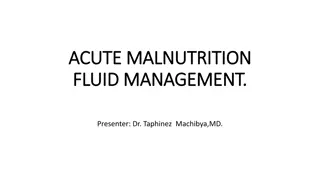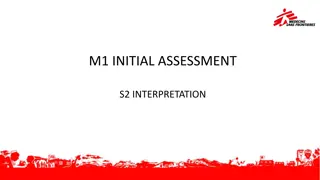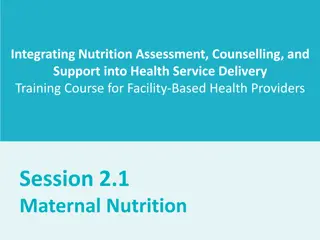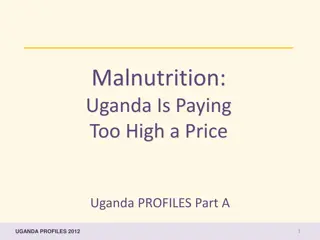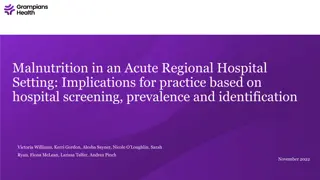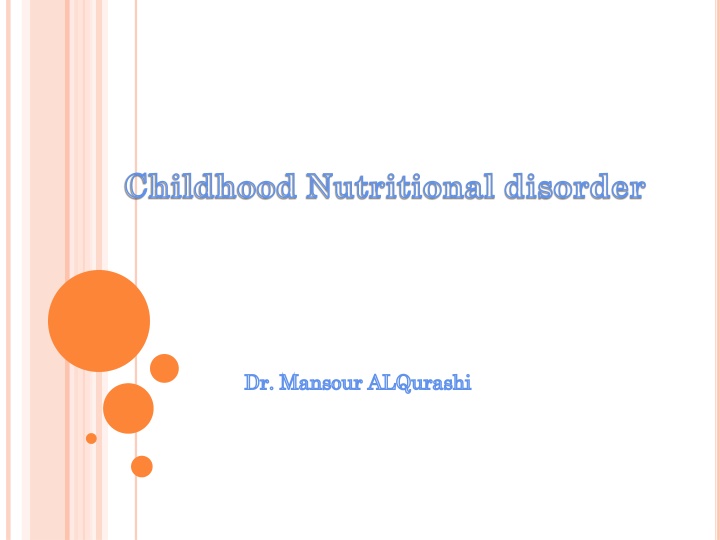
Childhood Nutritional Disorder
Explore the causes, types, assessment, complications, and investigations related to childhood nutritional disorders and malnutrition, including protein-energy malnutrition like marasmus. Learn about the importance of proper nutrition for children's health and well-being.
Download Presentation

Please find below an Image/Link to download the presentation.
The content on the website is provided AS IS for your information and personal use only. It may not be sold, licensed, or shared on other websites without obtaining consent from the author. If you encounter any issues during the download, it is possible that the publisher has removed the file from their server.
You are allowed to download the files provided on this website for personal or commercial use, subject to the condition that they are used lawfully. All files are the property of their respective owners.
The content on the website is provided AS IS for your information and personal use only. It may not be sold, licensed, or shared on other websites without obtaining consent from the author.
E N D
Presentation Transcript
Childhood Nutritional disorder Dr. Mansour ALQurashi
INTRODUCTION - Malnutrition is a condition that develops when the body does not get the proper amount of protein, calories, vitamins and other nutrients . - It occurs in children who are either undernourished or over nourished. Children who are over nourished may become over weight or obese. Children who are under nourished are more likely to have severe long term consequences.
ETIOLOGY 1- Dietary errors. 2 Infection : T.B, pyelonephritis. 3- Gastroenteritis 4- parasitic infestations : Ascaris, ankylostoma ,giardia. 5-Congenital anomalies : V.S.D, renal agenesis, pyloric stenosis . 6-Metabolic diseases : Galactosemia, Fructose intolerance. 7- Prematurity . 8- Some cases of mental retardation. 9- Low socio economic status . 10-Endocrine causes ( DM. hyperthyroidism ).
Protein energy malnutrition 1- Marasmus Definition: It is a form of under nutrition characterized by failure to gain weight due to inadequate caloric intake. Incidence: commonly in infants between the age of 6 mo. - 2years .
ASSESSMENTOF INFANTWITHMARASMUS failure a to thrive ,loss of weight (weight < 60%of expected) loss of subcutaneous fat : measured at many parts of the body according to the degress:- 1 st degree : s.c fat in the abd. wall 2 nd degree : s.c fat in the abd. wall and limbs 3 rd degree : s.c fat in the abd. wall and limbs and face
ASSESSMENTOF INFANTWITHMARASMUS (CONT.) Muscle prominence of bony surfaces ) G.I.T disturbances as anorexia in advanced cases, hungry, constipation or diarrhea. Liability to infection Hypovolemia Weak feeble pulse, subnormal temp, pulse rate Senile face Pallor wasting ( thin muscles and
COMPLICATIONSOF MARASMUS Intercurrent infection : Broncho pneumonia . is the cause of death Gastroenteritis. Hemorrhagic tendency, purpura. Hypothermia. Hypoglycemia. Edema (marasmic kwashiorkor ). 1. 2. 3. 4. 5. 6.
INVESTIGATIONSFOR MARASMIC INFANT 1.Blood analysis : W.B.C ,Electrolytes , Sugars, ketones , Plasma proteins . 2. Urine analysis: culture, sugar, ketones, ca, phosphate, amino acids. 3.Stool analysis for parasites. 4. X- ray for chest and heart. 5. Tuberculin test for T.B.
PREVENTION Proper diet ( balanced nutritional diet ). Encourage breast feeding up to weaning. Proper weaning. Proper vaccination as measles , T.B. whooping cough. Education regarding the cheap sources of balanced diet, family planning. Proper follow up of the growth rate. Early treatment of defects or associated diseases.
TREATMENT A- Proper dietary management:- Adequate balanced feeding. teaching about nutritional needs,preparation of diet, technique of administration of food. If there is vomiting or anorexia, give IV fluids or naso gastric tube feeding. Gradual increase the amount and concentration of formula (total calories is120-200cal kg /d). B Treatment of the cause. C- Emergency treatment for complications. D Blood transfusion. E Vitamins and minerals supplementation
KWASHIORKOR Definition It is a form of malnutrition characterized by slow rate of growth due to deficient of protein intake, high CHO diet and vitamins & minerals deficiency (adequate supply of calories). Incidence Commonly in toddlers between the age 1-3years, following or with weaning.
ETIOLOGY Un balanced diet (of protein, CHO.) improper weaning (during and post weaning period ) faulty management of marasmic baby Ignorance poverty due to lack of basic health education precipitating factors as(acute infection with measles, diarrhea and malaria, parasitic infestations) 1. 2. 3. 4. 5.
ASSESSMENT 1- Essential features (cardinal manifestation): Growth retardation :- Weight is diminished (60-80%) of expected Edema : It is due to hypo proteinemia. It is starts in the feet and lower parts of the legs) then becomes generalized edema . The cheeks become bulky, pale, waxy in appearance (doll-like- cheeks)
1- ESSENTIALFEATURES - Diminished muscle fat ratio: Generalized with subcutaneous fat - Fatty liver : It is detected by liver biopsy - Mental changes : The infant has apathy never smile, looks sad his cry is weak (muscle wasting)
2-EARLYFEATURES (USUALMANIFESTATION) Hair changes : The hair is sparse , dys pigmentation( reddish or greyish),atrophic ,easily pickable. G.I.T Manifestations: Anorexia ,vomiting in severe cases, diarrhea .
3-OCCASIONALORVARIABLE FEATURES - Vitamins and minerals defection and vit.D , A,C minerals as iron, zinc, Mg, Hepatomegaly. Skin changes (dermatitis in areas due to pigmentation ,napkin dermatitis, petechiae fissures,ulceration Poor resistance and liability to infections over the abdomen,
COMPLICATIONOFKWASHIORKOR CVS: hypovolemic shock. HF due to anemia and infection. GIT : atrophy of the pancreas with subsequent glucose intolerance, atrophy of the mucosa of the small intestine, lactase deficiency, ileus, bacterial overgrowth ( septicemia ). Gastroenteritis. Fatty liver. Loss of immune function, antioxidant function, subsequent infections, UTI,septic shock, and death. Both bacterial and fungal. Endocrinopathies : insulin levels are decreased; growth hormone is increased, but insulin-like growth factor levels are reduced. This leads to insulin intolerance. Hypoglycemia Metabolic disturbances and hypothermia,Acidosis. Impaired cellular functions, including endothelial dysfunction Electrolyte abnormalities. Hemorrhagic tendency, purpura
INVESTIGATIONSFORKWASHIORKOR 1. Blood analysis: (Albumin < 2.5gmld) , total protein, amino acids, Enzymes (amylase ,lipase, alkaline phosphate, ,Glucose (hypoglycemia) , k(hypokalemia ), Creatinine blood levels,ABG. 2. Low pancreatic and intestinal enzymes 3. Urine analysis, culture for infection 4. Stool analysis for parasites 5. Chest x-ray 6. Tuberculin test
TREATMENTOF KWASHIORKOR Food with more proteins and more calories. Long term vitamin and mineral supplements. Calories need to be increased slowly because the patient s diet lacked any significant nutrition for a long period. If there is a delay in the treatment, the child might stay with permanent disabilities. If the condition is not treated, it might turn fatal. physical and mental


